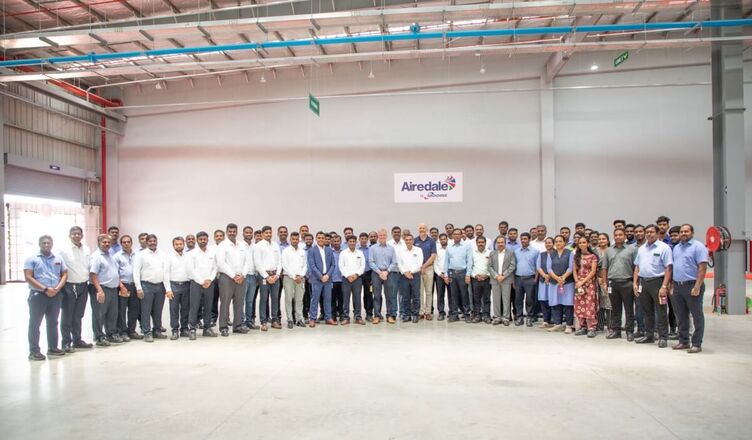
Modine is expanding its footprint in the North American data center market with the launch of a new manufacturing facility in Franklin, Wisconsin, aimed squarely at the surging demand for high-efficiency cooling systems driven by cloud, AI and hyperscale workloads.
The company, listed on the NYSE under the ticker MOD, has officially opened a 155,000-square-foot plant that will focus on producing Airedale by Modine data center cooling solutions. The site forms a central pillar of a previously announced multi-year, US$100 million investment program to scale production capacity for digital infrastructure.
According to Modine, the Franklin facility is expected to generate more than 300 new jobs by March 2026, with headcount projected to reach about 430 employees within three years. The expansion is intended to support mission-critical environments where thermal performance, uptime and energy efficiency are under simultaneous pressure.
“We are proud to do advanced manufacturing in Wisconsin,” said Art Laszlo, Group Vice President, Global Data Centers at Modine. He framed the facility as both a capacity play and a strategic bet on long-term digital infrastructure growth. “This facility not only strengthens our ability to meet growing demand for Airedale by Modine data center cooling products, it also represents a strategic investment in our future and a commitment to delivering innovative cooling solutions for mission-critical operations.”
New plant in Grand Prairie, Texas
The new plant is part of a broader, multi-site strategy. In addition to Franklin, the US$100 million investment covers a new manufacturing facility in Grand Prairie, Texas, and capacity expansions in Grenada, Mississippi, and Jefferson City, Missouri. Beyond manufacturing volume, the program is also designed to boost engineering, product development and testing capabilities, while supporting retraining and redeployment of existing Modine employees across its network.
For Modine, Wisconsin is more than just another pin on the map. The company was founded in Racine in 1916 and still maintains its global headquarters in the state. Historically, Modine has supplied thermal technologies ranging from radiators for the Ford Model T to aftercoolers for the P-51 Mustang fighter during World War II. The Franklin expansion links that industrial heritage to contemporary digital infrastructure needs.
From a data center strategy perspective, Wisconsin is positioning itself as an alternative hub location in the US. Its abundant water resources, comparatively stable and reliable electricity supply and naturally cooler climate can help reduce cooling costs for energy-intensive facilities. At the same time, available land and an experienced construction workforce are making the state incrementally more attractive for operators planning large-scale AI and cloud deployments away from overheated core markets.
“Franklin’s collaborative spirit, a strong workforce and support for industrial growth made it an ideal location for this expansion,” said John Williams, Group Vice President, Data Centers, Americas. He credited both the City of Franklin and the State of Wisconsin with providing support throughout the development process, positioning Modine for what the company describes as long-term success in the sector.
For global CIOs, cloud providers and colocation operators, the move underlines how thermal management vendors are retooling their industrial base to cope with rapidly changing rack densities and energy constraints. As AI and accelerated computing continue to push power usage per rack upwards, the market for high-efficiency air and liquid-based cooling is becoming a key battleground, with suppliers racing to deliver more capacity, more configurability and better integration with facility-level energy strategies.
Modine’s bet in Franklin is therefore not just a local manufacturing story. It is a signal that the supply chain for data center cooling is scaling up in anticipation of continued growth in digital infrastructure – and that secondary markets such as Wisconsin are increasingly part of that equation.
Executive Insights FAQ: Data Center Cooling Trends
Why is data center cooling capacity such a hot topic right now?
AI workloads, GPU-dense racks and high-performance computing have pushed rack power densities sharply higher. Traditional cooling architectures designed for 5–10 kW per rack are being stretched by deployments exceeding 30–50 kW, making thermal management a strategic constraint rather than a background utility.
Are operators shifting away from air cooling to liquid-based systems?
Not entirely, but there is a clear hybrid trend. Many facilities still deploy advanced air-based or indirect evaporative systems at the building level, while liquid cooling (direct-to-chip or immersion) is increasingly used for the hottest racks. The result is a mixed environment that requires vendors to support both air and liquid approaches.
What role does sustainability play in cooling technology choices?
Sustainability and ESG targets are reshaping cooling decisions. Operators are under pressure to reduce water use, minimize refrigerants with high global warming potential and cut overall energy consumption. This is driving interest in high-efficiency chillers, adiabatic systems, advanced controls and heat reuse concepts.
How are manufacturers responding to this demand shift?
Suppliers are expanding production capacity, as Modine is doing, and investing in R&D for higher-efficiency systems, modular solutions and better integration with building management and DCIM platforms. Shorter lead times, configurability and lifecycle support are becoming as important as raw thermal performance.
What should data center buyers prioritize when evaluating cooling partners?
Beyond upfront cost, buyers should look at total cost of ownership, energy efficiency, support for future higher rack densities, the vendor’s roadmap for liquid cooling, and their ability to deliver at scale. Proven experience in mission-critical environments and strong local service and maintenance capabilities are also key differentiators.

